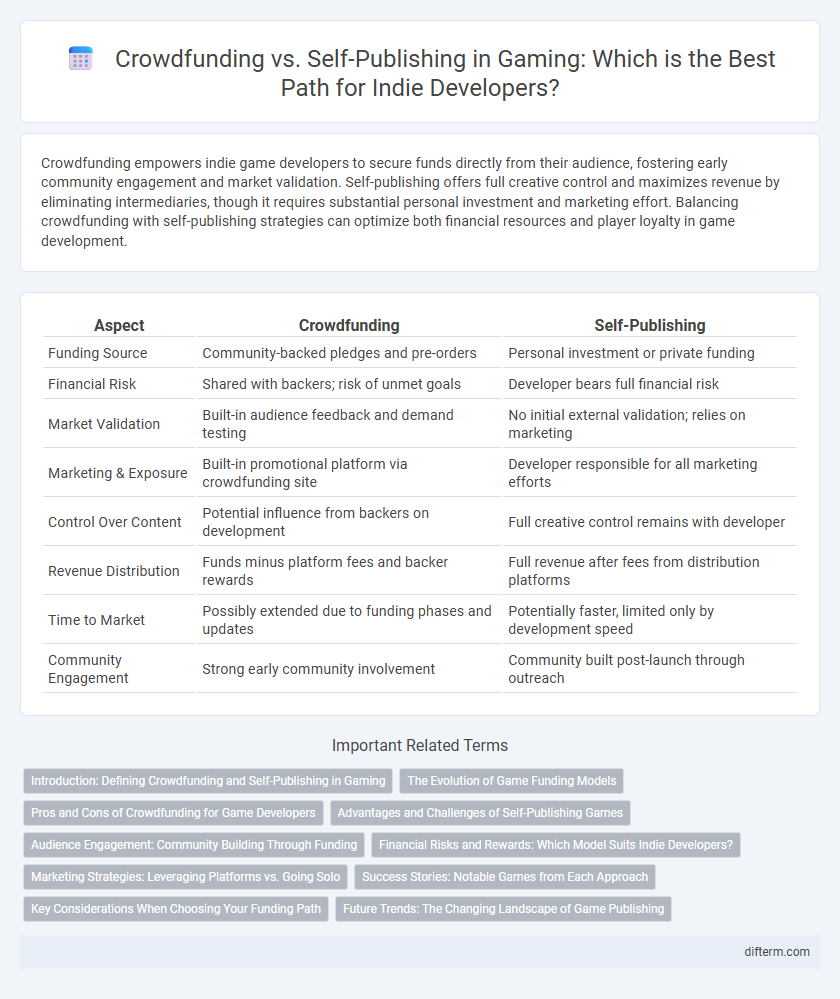Crowdfunding empowers indie game developers to secure funds directly from their audience, fostering early community engagement and market validation. Self-publishing offers full creative control and maximizes revenue by eliminating intermediaries, though it requires substantial personal investment and marketing effort. Balancing crowdfunding with self-publishing strategies can optimize both financial resources and player loyalty in game development.
Table of Comparison
| Aspect | Crowdfunding | Self-Publishing |
|---|---|---|
| Funding Source | Community-backed pledges and pre-orders | Personal investment or private funding |
| Financial Risk | Shared with backers; risk of unmet goals | Developer bears full financial risk |
| Market Validation | Built-in audience feedback and demand testing | No initial external validation; relies on marketing |
| Marketing & Exposure | Built-in promotional platform via crowdfunding site | Developer responsible for all marketing efforts |
| Control Over Content | Potential influence from backers on development | Full creative control remains with developer |
| Revenue Distribution | Funds minus platform fees and backer rewards | Full revenue after fees from distribution platforms |
| Time to Market | Possibly extended due to funding phases and updates | Potentially faster, limited only by development speed |
| Community Engagement | Strong early community involvement | Community built post-launch through outreach |
Introduction: Defining Crowdfunding and Self-Publishing in Gaming
Crowdfunding in gaming involves raising capital from a large number of backers through platforms like Kickstarter or Indiegogo to finance game development, often securing early community support and feedback. Self-publishing refers to developers independently releasing games without traditional publishers, controlling distribution, marketing, and revenue streams directly. These models offer alternative pathways for game creators to fund and launch projects while maintaining creative autonomy and engaging target audiences.
The Evolution of Game Funding Models
Game funding models have evolved significantly, shifting from traditional self-publishing, where developers fully finance and control their projects, to crowdfunding platforms like Kickstarter that enable direct community investment and early fan engagement. Crowdfunding reduces financial risk and validates market demand before production, while self-publishing maintains complete creative control and profit retention for developers. This transformation empowers indie developers to access capital and build audiences, reshaping how games are brought to market in the digital era.
Pros and Cons of Crowdfunding for Game Developers
Crowdfunding offers game developers access to upfront capital and a dedicated community, enabling creative freedom without traditional publisher constraints. However, it requires significant marketing effort, risk of public failure, and the challenge of managing backer expectations. Developers may also face delays and pressure to deliver promised features, impacting overall project timelines and quality.
Advantages and Challenges of Self-Publishing Games
Self-publishing games provides developers full creative control and the ability to retain a larger share of revenue compared to crowdfunding, which often requires sharing profits and managing backer expectations. The main advantages include faster decision-making, direct connection with the audience, and the potential for immediate market entry. Challenges involve shouldering all marketing, distribution, and financial risks without the upfront funding that crowdfunding campaigns offer.
Audience Engagement: Community Building Through Funding
Crowdfunding fosters deep audience engagement by turning backers into active community members who contribute feedback and promote the game pre-release. This participatory approach enhances player investment and creates a loyal fanbase eager for updates and shared experiences. Self-publishing, while offering creative control, often lacks the built-in community that crowdfunding campaigns organically develop through transparent communication and collaborative funding milestones.
Financial Risks and Rewards: Which Model Suits Indie Developers?
Crowdfunding offers indie developers upfront capital without giving away equity but carries the risk of failing to meet funding goals, potentially stalling project development. Self-publishing requires developers to invest personal funds, increasing financial exposure but enabling full control over profits and creative direction. Indie developers seeking immediate financial backing might prefer crowdfunding, while those with available resources aiming for long-term revenue and autonomy may opt for self-publishing.
Marketing Strategies: Leveraging Platforms vs. Going Solo
Crowdfunding campaigns harness established platforms like Kickstarter and Indiegogo to tap into built-in audiences, generating buzz and early community engagement that fuels organic marketing momentum. Self-publishing requires developers to independently craft targeted marketing strategies across social media, influencer partnerships, and content marketing, making personal branding and network building critical for visibility. Leveraging platform-driven exposure accelerates market penetration, while going solo demands resourceful, continuous promotion to achieve competitive reach.
Success Stories: Notable Games from Each Approach
Kickstarter's crowdfunding success stories include "Undertale" and "Shovel Knight," showcasing how fan-driven funding can build communities and secure creative freedom. Self-publishing triumphs like "Minecraft" and "Stardew Valley" demonstrate the power of direct market control, allowing developers to maximize profits and iterate quickly. Both models offer viable paths to success depending on resource access and risk tolerance.
Key Considerations When Choosing Your Funding Path
Evaluating funding paths for gaming projects involves assessing financial control, risk tolerance, and community engagement. Crowdfunding offers early audience validation and marketing benefits but requires significant promotion and fulfillment commitments. Self-publishing allows full creative ownership and revenue retention, demanding upfront capital and comprehensive market strategy.
Future Trends: The Changing Landscape of Game Publishing
Crowdfunding platforms like Kickstarter and Indiegogo empower indie developers to secure initial funding and build community support ahead of launch, reshaping traditional publishing models. Self-publishing on digital storefronts such as Steam and Epic Games Store offers direct access to global audiences, enhancing creative control and revenue share. Emerging trends indicate increased hybrid approaches combining crowdfunding with self-publishing, supported by AI-driven marketing tools and blockchain-based asset management, signaling a more decentralized and democratized future for game publishing.
crowdfunding vs self-publishing Infographic

 difterm.com
difterm.com